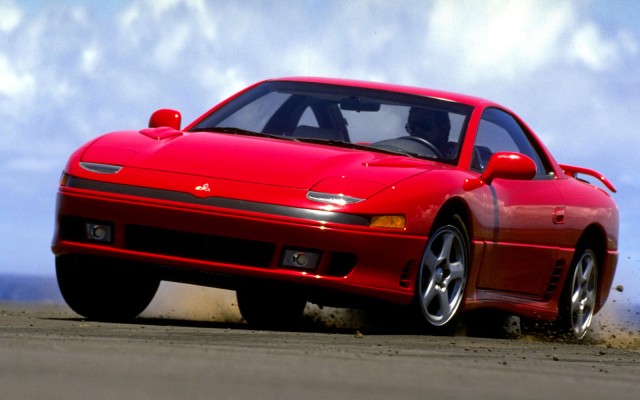
If you had to rank the social pecking order of JDM performance cars, then the Skyline GT-R would be the king. No matter what marque you favor, it’s hard to argue against the decades of motorsport glory and performance folklore that surrounds Nissan’s finest product. After that, you might have the RX-7 with its seductive curves and turbo rotary cool, and of course the Supra is covered in Paul Walker fairy dust and 2JZ engine mythos. Nissan also has the Z, still such an evocative nameplate even today, especially in Japan. Subaru? Well those guys are steeped in rally lore and so is Mitsubishi with its Lancer Evolution, all sideways and airborne through a Finnish forest somewhere. And that’s it, isn’t it?

Well, not really. Mitsubishi’s brand message is so embedded with boxy rally cars that it’s sometimes easy to forget that it does have a heritage in GT coupes, going right back to the Galant GTO of the early 1970s, and then the Starion of the 1980s.
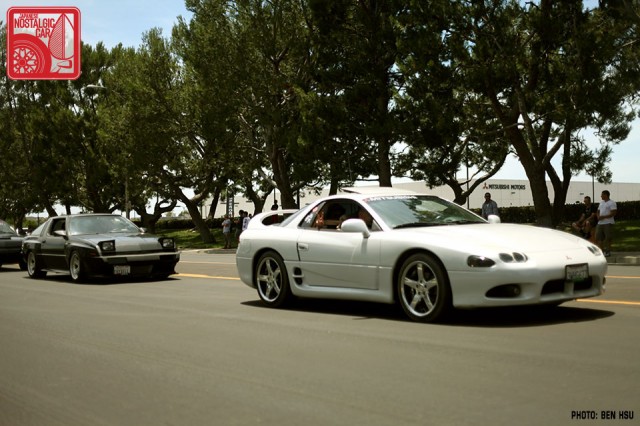
After the Mitsubishi HSX Concept debuted at the 1989 Tokyo Motor Show, rumors began to circulate of a “Super Starion” to debut at the Tokyo Motor Show that year. And just like all the halo performance products of that era — such as the R32 Skyline GT-R and the NSX — the new Mitsubishi coupe promised to take performance to a new level for the Diamond Star marque.

Under the slogans of “New Motoring Wave” and “Super 4WD Sports”, the Mitsubishi GTO went on sale in October of 1989 in Japan. For a home market addicted to gadgets, the new GTO gave them… well, lots of gadgets. The headline was the VR-4, equipped with a twin-turbo 3.0 V6 that fed its 276 horsepower into a 5-speed transmission and an AWD drivetrain.
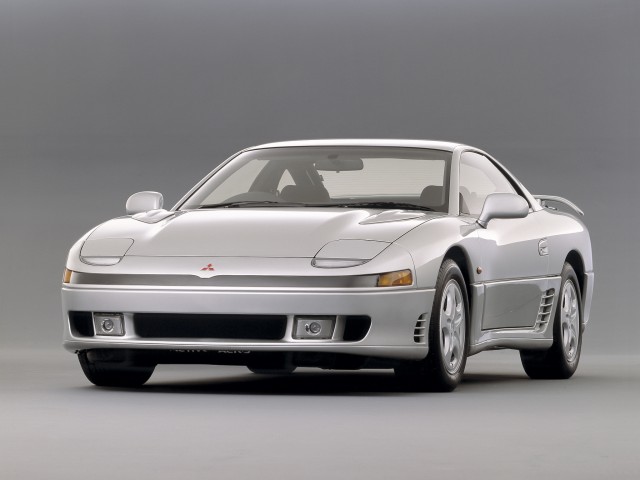
Unlike the its 90s Wangan rivals, the engine was transversely mounted, and in lesser guises was a front-driver. Like its competitors, though, the 276 figure was part of the Gentleman’s Agreement among Japanese automakers at the time. In reality, everyone was violating it, and in the US the 3000GT put 296 hp on paper.
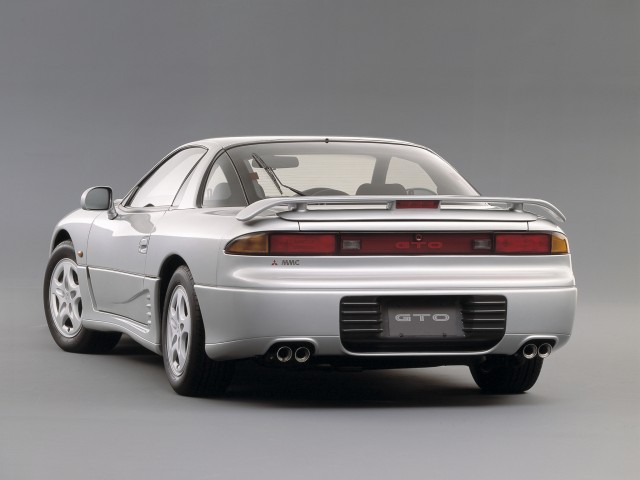
It also had electronically adjustable shocks, which would harden or soften based on speed, throttle, steering angle and cornering G. The brakes had 4-channel ABS and aluminum calipers, the driveshaft was made of high-tensile steel, and the rear suspension had both active and passive steering, the former allowing up to 15 degrees of lock depending on conditions. The performance package would be topped off with moveable front and rear spoilers, which would deploy above at speed.

On the inside, drivers found a cabin with more lounging room that most Japanese coupes, and were pampered with electric seats that had powered lumbar adjustment and a full climate control system with a groovy multi-colored screen display that was quite something. Oh, and there were lots of buttons for the electronic shocks, spoilers and also a switch to make the exhaust “Normal” or “Silent”.

And all this stuff came at a cost, however, in terms of weight, and when it debuted at the Tokyo Motor Show the GTO troubled its display stand to the tune of 3,790 pounds. This was quite a statement, in the context of the 2,735-pound FD RX-7, the 2,755-pound NSX and the 3,045 Skyline, which was deliberately stripped back to evoke the heritage of its lightweight 2000GT-R predecessors.
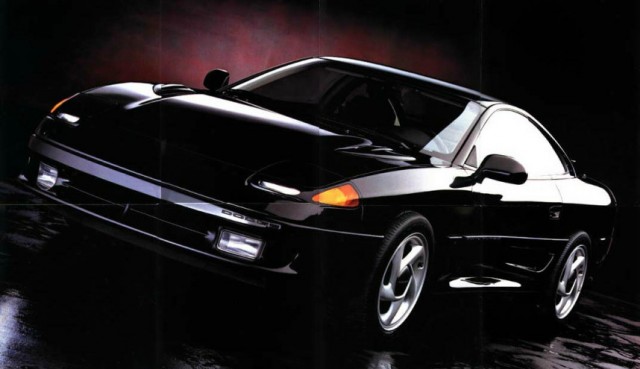
In the US, it was sold as simply the 3000GT. Because of Mitsubishi’s partnership with Chrysler, a reskinned and rebadged version was sold as the Dodge Stealth, with the R/T being the VR-4 equivalent. With fewer strakes and vents, it was considered the better-looking car at the time. In retrospect, however, it’s the Mitsubishi version that’s less 90s “organic” rounded, more uniquely Japanese, and has aged more gracefully.
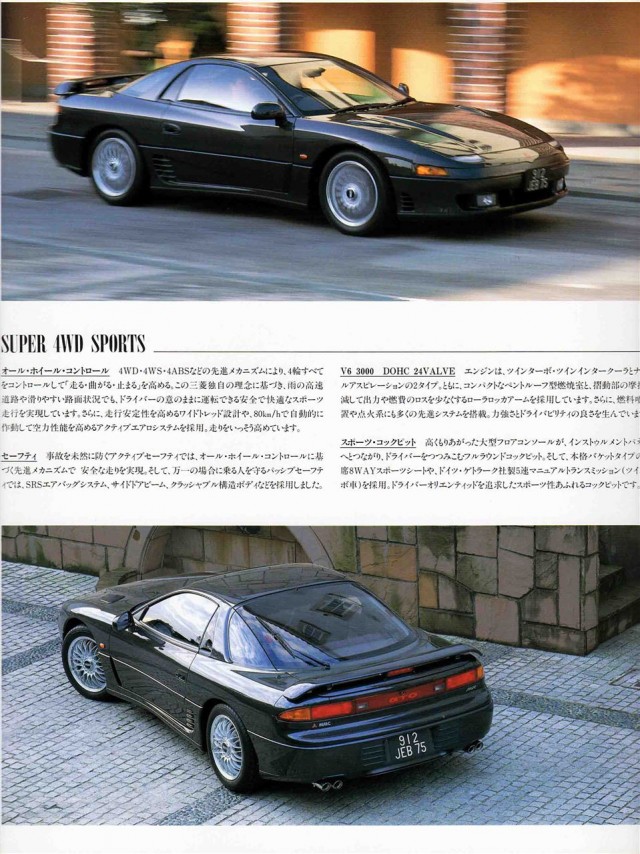
Car magazines at the time commended the GTO for having an admirable measure of straight-line stomp, and in this regard the GTO compared very favorably with its 90s JDM brethren. Having a pair of small and fast spooling turbos that meant that peak torque arrived at a very early 2500 rpm. Just as well, since the early 5 speed GTOs had extraordinarily tall gearing that would see third gear stretch to almost 120 mph.
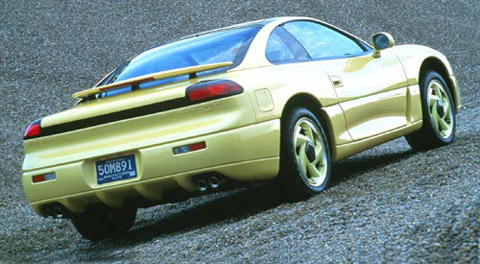
This meant that a GTO was a very relaxed freeway cruiser, but the powertrain was nonetheless stout enough for Popular Mechanics to get a 13.4-second quarter-mile out of one. Dragstrip potential aside, the GTO did score some criticism in period for having a chassis that was a little bit of a blunt instrument. Car magazines all over the world repeated the same mantra that it was a stable corner carver and capable handler with a high threshold of grip, if not very involving and perhaps a little nose heavy.
At some point after the initial fanfare, however the world seemed to just… forget.
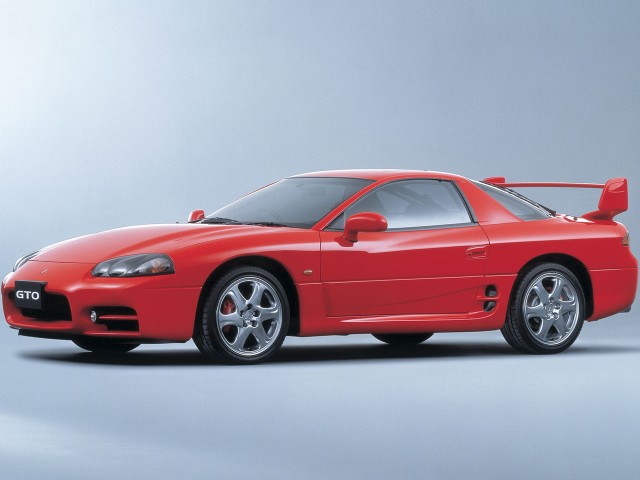
It didn’t help that it wasn’t a natural tuner superstar. Those little twin turbos meant that unlike its 90s JDM siblings, a GTO isn’t a few simple tweaks away from 450hp. A weak gearbox and great weight also hampered its tuning potential in an era where Mine’s Skylines and Top Secret Supras were stealing all the limelight in the local magazines.





Neither did the GTO cover itself in motorsport glory. In the 1990s, Mitsubishi was busy earning four consecutive WRC championships, so the GTO never saw any track action apart from some strong showings in the Super Taikyu series from 1994 to 1996. Crucially the N1 rules had engine capacity based weight limits, which allowed the GTO to shed quite a lot of kilos and the Puma team cars ran at a far more reasonable 3,220 pounds (in comparison the Skylines could only reduce their weight to 2,910, barely less than stock) while boosting power to 375 hp.
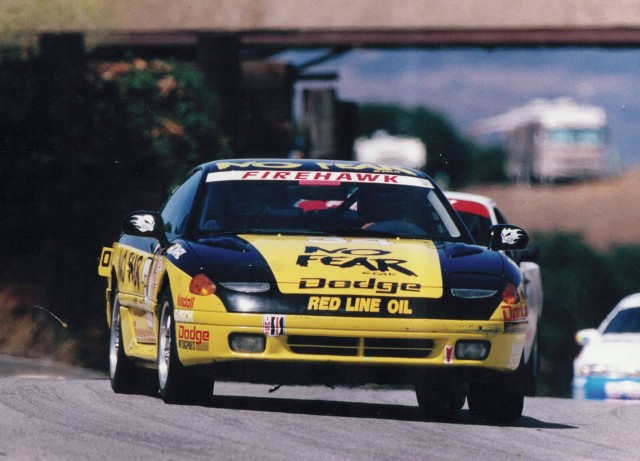
In the US, Peter Cunningham (of RealTime Racing Acura fame), Andy Pilgrim and guest driver Boris Said took a Dodge Stealth to first place in Sports class of the the 12 Hours of Sebring in 1992. The win gave Said the driver’s championship, breaking a tie with Peter Farrell in an FC Mazda RX-7 Turbo II. Cunningham came in fourth, one point behind Said (photo courtesy of Peter Cunningham).

To its credit, Mitsubishi did continue to develop the GTO over time, and in 1994 it scored a major upgrade, with fixed headlights replacing the pop-ups, and most notably, a much stronger Getrag 6-speed replacing the old shifter. Horsepower increased to 320 in US versions, and Mitsubishi stunned the market in 1995 when by offering the first production folding metal hardtop convertible.
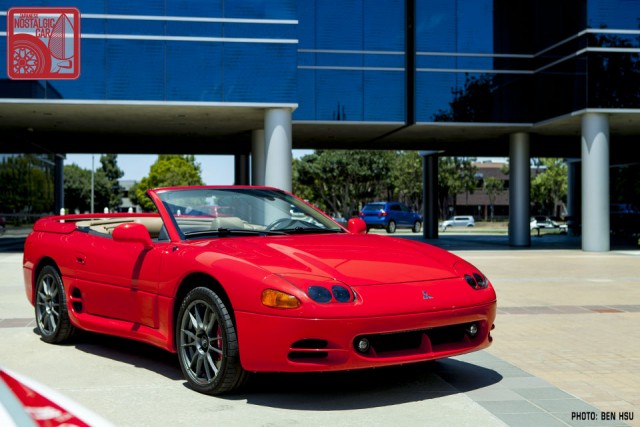
Top-spec VR-4 Spyders retailed around $65,000 (for comparison, an RX-7 was just $37,363), about $20,000 over a fixed-head VR-4. Converted by ASC, they were never sold anywhere outside North America, including the motherland.
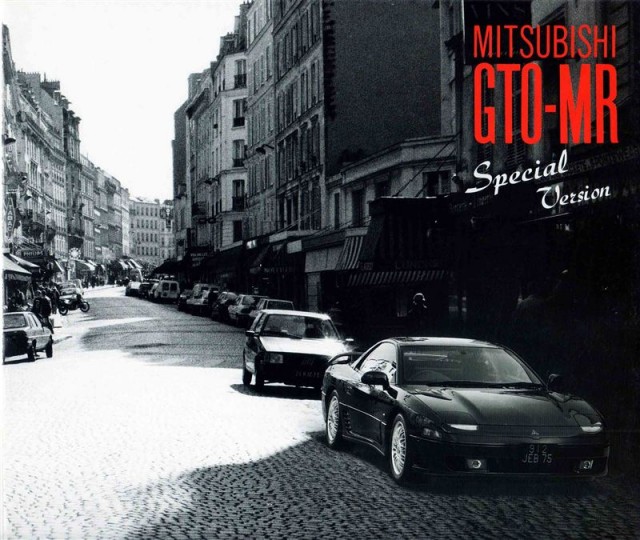
In Japan, an MR version would also be offered, with factory BBS wheels, optional 6-pot brake calipers, and a 66-pound weight saving coming from deleting the rear wheel steering, electric shocks and replacing the active aero with fixed spoilers.
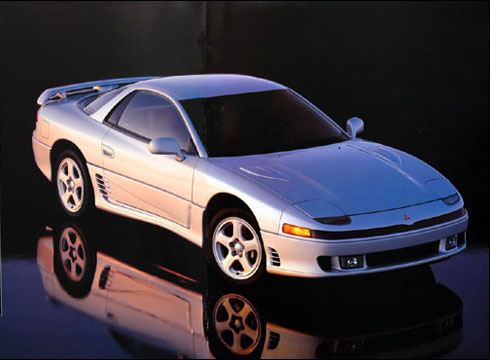
To my eyes, time has been kind to the GTO shape. It’s festooned with all sorts of scoops, vents, grilles and blackout panels (there’s even a fake window in the b-pillar) but look at a pristine early model in white and as Ben says, it looks like a Gundam on wheels. It could be nothing but a product of post Bubble Economy Japan, and proudly so.

In its home market, the GTO always has been regarded as worthy; a muscle coupe in a sea of pure sports cars. Sure, it was never a Best Motoring Tsukuba hot lap star, but it’s more tractable than an RX-7 in your daily commute, more comfortable than a Skyline, and easier to handle than a Supra when the roads get wet or snowy. If I had to pick a charismatic and burly 90s JDM supercar for a long, stress-free road trip, I’d want the GTO. If an RX-7 is Japan’s Porsche 911 then the GTO is its 928, and there ain’t nothing wrong with that.






Starting to feel old, they were a new car the other day !
As much as I’d like to jump up for joy, my feeling is these haven’t aged well.
Of of my TOP5 dream cars. Defenetly in green with white accents, reminescent to the Puma livery, witch a saw in Gran Turismo 1 for the 1st time.
A very underapriciated car. It should be considered as the only worthy opponent for GT-R, esspecially the R33. In terms of technical sophistication and overall layout they have some commons.
Here, in Europe, most people are affraid of them, due to extremly hight maintance costs, complicated servicing and for reasons unkown to me the 3000GT’s (here they are called the same as in US – thx Ferrari :E ) earned a reputation of poser- of duchebag- cars. Sadly. But is admire they “Gundam Mecha” apparence 😉
They are difficult and expensive to properly maintain. Couple that with rock bottom prices for many years and many examples that had fallen into disrepair, remained in poor condition. Thus continuing to fuel many people’s poor opinion of the cars. Other wise they where an interesting example of a ’90s halo car. I’ve seen several nice convertibles versions in person and they are rising in value and desirability. There was actually a time frame when MMNA was purchasing convertibles to use as parts donors and parts to make the tops work are very scarce.
I think the parts support would definitely be the most challenging, compared to Skyline, Supra or RX-7 (where the supply is actually pretty good).
In terms of ease of mechanical access though, I’d say it’s no more or less of a maintenance moneypit than a Skyline GT-R…which is one of those mechanically jam-packed cars, where if you need to access the water temp sensor, you have to remove the rear suspension first
Well, difficult but not impossible and couple that with an owner who may have purchased it for dirt cheap and doesn’t care about the car, you have a bad combination. Sadly I don’t think these will ever have the desirability of a Skyline. I mean it’s all relative, I work on a lot of Mitsubishi products and after awhile they all have a familiarity that makes working on them feel easy.
If anybody is interest in buy one of this check in argentina sales pages (mercadolibre, etc), a few examples with low kilometers, queen garages car for a reasonable amount of pesos / dollars. Maybe can you make a happy day!!!
Wow, were they sold as new cars in Argentina, or would they have been imported as used cars from Japan?
not sure exactly, but please check, make your own conversion, maybe with the dollars in hand (good luck in the airport) is a bargain
http://auto.mercadolibre.com.ar/MLA-577496165-mitsubishi-gt3000-1993-vr4-biturbo-34600-millas-de-coleccion-_JM
http://auto.mercadolibre.com.ar/MLA-582684460-mitsubishi-3000-gt-vr4-biturbo-32700-km-titular-_JM
http://auto.mercadolibre.com.ar/MLA-556783361-mitsubishi-gt-3000-vr4-linea-nueva-unica-18000-km-_JM
Uh, you didn’t mention the GTO/3000GT greatest moment; Jackie Chan drove a GTO in the movie Thunderbolt.
http://www.imcdb.org/vehicle_7053-Mitsubishi-GTO-1991.html
Let us not speak of that again.
No, the thing we do not speak of is it was the second worse car in Wangan Midnight Maximum Tune.
What’s even more interesting it wasn’t ever featured in the WM manga. In the anime it was shown only two or three times as traffic car only.
But when we’r around games, the GTO TwinTurbo was the best and unbeatable car in first two installements of Gran Turismo. The only other machine cappable of fighting with it when fully tuned was the Impreza GC 22B STi, not the BCNR33, JZA80 or FD3S.
And the Ferrari and Gembella Porsche wasn’t featured in some ports of the game.
that was an fto that chan drove
No donnie, the FTO was driven in the beginning. But during the “climax race”, it was a Mitsu race team that showed up with GTO’s for the Chan to drive.
GTO
Fantastic piece, I especially like the Porsche analogy at the end. I remember Autocar comparing the Supra and 928 and concluding they weren’t really the same type of car, it’s believable that the GTO would have been more akin.
My favourite amusing detail about these cars is the damper blisters:
Mitsubishi Engineer 1: Great news, we’re done with the ECS work
Mitsubishi Engineer 2: Cool, lets close the bonnet and go for a spin. Er, why won’t the bonnet close?
Mitsubishi Engineer 1: Oh yeah, need to speak to the body guys about that, they need to change the bonnet line to make space for the damper control units
Mitsubishi Engineer 2: But we don’t have time to re-shape the bonnet, the toolings’ already being made
Mitsubishi Engineer 1: Kuso! Well, I guess maybe just cut some holes and stick some plastic covers over the top?
There’s a really nice appreciative piece over here on Jalopnik about buying one of these – including some great pics: http://thegarage.jalopnik.com/i-just-lost-25-500-on-my-mitsubishi-3000gt-vr4-and-i-c-1727993125
Not my favourite bubble-era car, but deserving of appreciation for what it is, as you say.
I was wondering when a article was going to be written about these. They are fantastic cars, when they work! My brother has had one for a number of years, with the AWD/Active Aero/Active Suspension etc. The Active Aero/suspension doesn’t work any-more though (I would be curious to see how many early models still do) My brother looks after it and takes it to the occasional car meet-up/show (its usually the only example at the entire meet-up/show)
All it taught me though was never buy one! Here in Australia they are a very rare car, so good luck finding someone who will work on it, and anything that needs to be done costs a fortune because the engine bay is so ludicrously packed. Parts? Yeah good luck with that! Though after market stuff from Japan and America does exist. The cabin does not have that much room, especially for taller people. If you did not think you had claustrophobia, you soon will if you try getting in the back seat! Despite all this however, I don’t want to detract people from getting one, they are really cool. Guaranteed to get attention (mostly male attention…). Just be prepared, if you do decide to buy one… They should be looked after and preserved especially now Mitsubishi has decided to not make anything good whatsoever any-more. Oh well I followed in my brothers footsteps and got a forgotten rarity myself with the Nissan NX-Coupe, speaking of which, aren’t they considered ‘nostalgic’ now along with its Sentra sibling?
just saw two really nice examples a few days ago
Gotta finish my AMT Dodge Stealth model kit then.
Love the article! I have owned my VR4 (modified) for 3 years and my SL for 6 and they’ve been wonderful to me. You can’t beat those curves lol. One thing that I wanna point out from your article is when you mentioned that the 6 speeds are stronger than the 5 speed. Common misconception. 5 speeds with a 25 spline transfer case (92-93) are stronger. But I’m just nit picking here.
We didn’t wanna overload the article with too much info, but yes, our understanding is that the 5spd is actually stronger than the 6spd, it’s just that 6spds came with a stronger transfer case and is the stouter combo overall. So the ultimate would be the 6spd transfer case with the 5spd box.
But we’re getting seriously drivetrain-geeky here 🙂
They were nice to have around. Good looking and added depth to whole hot Japanese car field. A pearl white one lived on my street in my kid days, wasn’t VR4 though. I wish Mitsubishi had done better over these last decades, I think they are going to go extinct as far as cars.
And the pearl yellow is among the very best colors I’ve ever seen. And I do not like yellow cars as a rule. I think it look lighter in the flesh than it does in pics.
PS The GTR wasn’t the king, the Supra was. The GTR had 4WD, but so did a lot of other cars. GTR had conservative, safe, bland styling (part of its appeal, many would probably say). The Supra had a bigger engine, and a gorgeous body that still looks hot as f to anybody today. Put a Supra and a Skyline next to each other in a parking lot and somebody who knows nothing about cars will recognize the Supra instantly as something special and badass. The Skyline look shabby in comparison. Also the most outrageous Supras are more outrageous than the most outrageous GTRs. Plus top Toyota > top Nissan.
Technologically, this car became “nostalgic” much faster than 25 years.
A few points.
Internationally, the GTO was only ever sold in AWD guise. The lower trim cars featured N/A engines paired with transmissions and transfer cases based on the ones found in AWD DSMs (Eclipse, Talon and Laser). Two chassis codes existed, the Z15A, being AWD and Z16A, AWD with dual steering. The base 3000GT, available only in North America was a Z11A and the rear suspension is completely different. You can’t simply swap over the rear subframe from an AWD car.
Having a FWD lower car in the US certainly hurt the cars image, drawing comparisons to a Grand Prix or Toyota Solara. Never-mind the super car looks paired with a weezy sub-200hp V6 and a sluggish automatic, the base car screamed “poser” while holding a ridiculous price tag.
The cars are no harder to maintain then any of it’s contemporary rivals. It was not long ago people moaned about the horrors of the 13BEW and the impossible task of maintaining an FD3S. The perpetually unavailable interior trim bits that where made of powder, busted door handles, easily scratched glass, etc. Now the car can do no wrong and prices are soaring as MKIV Supras have long left the grasps of mere mortals.
The 5spd is every bit as strong as the 6spd transmission, it is the 5spd’s transfer case with it’s aluminum housing that is prone to failure. The 6spd features an iron transfer case, but then the 6spds bell-housing becomes the failure point. Mind you, this is in cars with +600whp doing clutch drops. By comparison to a W58, Subaru 5spd or DSM setup, the TT setup is indestructible.
Additionally, the US Spec 6spd was even longer in the gears then the 5spd. 6th gear is practically useless under 75mph. The international 6spd has very short, tight gearing with the final R&P being the same as the USDM 5spd. The JDM 6spd was sold along side the 5spd as an upgrade in the later years. European cars also got larger turbos then their US and JDM counterparts.
Going back to spare parts, in the US, they are very common. This is because of the base N/A cars sharing much of the same interior and exterior to the turbo cars. The N/A cars have basically remained under the radar for the last 15 years.
Lastly, as a fun fact, the 3000GT’s side mirrors are asymmetrical. Much like an 80’s 911, the passenger mirror is located further back then the driver mirror to maximize visibility. Once you see it, you can’t un-see it.
I just sold my Black 1997 VR4 recently. Bought it in 1997. Loved the car. Wonderful vehicle. I put 100K miles on it. Truly a great car.
Why did I sell it? Parts were getting difficult to find and expensive. Cost me almost $1000 to replace the fuel pump when it went out. With 140K miles I could see it was reaching the point of going to need some major work and I was not confident of finding parts. The ECM needed replaced. There are no replacement ECM’s. I did find a used, rebuilt one. A lady backed into the passenger door a couple years ago. My body shop told me I was lucky she hit the door instead of the fenders. He found three right hand doors in the US and NO fenders. Hated to see it go. Used the cash to buy a new Mustang GT.
Wow $1000 to replace a fuel pump? I did it myself for waaaaayyy less than that. Idk if you’ve been in the community but parts are relatively cheap thanks to the people at Ninja Performance, 3SX, IMR, Maximal Performance, Cherry Hill Mitsubishi, etc etc. Comparable (or less actually since we have the luxury of having tons of VR4s, SL’s base models, Stealth RT, Stealth RTTTs, and Stealth base models being parted out; 3000GTs/Stealths sold well in NA compared to its competition contrary to popular belief) to the other 90s Japanese sports cars. But I understand that you had to let it go. These cars are pretty complicated and, honestly, there’s better stuff out there today. Not a car for everyone. At least you kept it for a long time.
It was a bit less than $1000. The fuel pump wasn’t that much. What cost so much was the tow to the shop and the labor to get to the fuel pump. I loved the car. I owned it for 18 years. Short of the regular maintenance and a couple of water pumps, I never really had many issues with it. Finding an ECM was an issue. Turned out the issue was a vacuum motor but the ECM was in pretty poor shape and couldn’t be rebuilt. I would have been money ahead to get the aftermarket unit instead of the three used ones I purchased, two were junk. The rebuilt one was working fine when I sold it. Got $9500 for the car with 140K miles on it. The only mod was the air cleaner had been replaced when I got it. The buyer told me mine was the only VR4 that he found that was not modded. Love my New Mustang GT. Ordered it with the Performance Pack. 435 HP 400 ft lbs torque. 6 speed. 100+ more HP than my VR4.
hi Guys
Im looking for the Wheel Part Number: #65699 x 4 pieces
1991-1993 Mitsubishi 3000GT
Size: 16″ x 8″, 5 Lug, 4.5″ Bolt Pattern
Finish: Silver
Description: Used 5 Spoke Original Alloy Rim
Condition: reused
can anyone help me out
Pat Wong, I might have four wheels you are looking for. Came off a 93 GT. Email me and I will send pics of what I have. I have long since traded that car in on a 97 VR4 but kept the wheels. I replaced those on the car with aftermarket rims.
Dennis
Can you kindly please send me the picture of the rims.
looking forward to her from you
cheers bro
Pat, I will need to dig them out of storage. Not a big deal but will take a bit of effort. Haven’t seen them for a few years under one of my benches in my garage. 🙂
How I do send you pics of these? Don’t see that I can upload them here.
Dennis
Dennis
you may send it to nkwong1960@yahoo.com and cc acopy to 106259@gmail.com
really look forward to hearing from you.
have a great weekend a head !
cheers bro
Rgds
pat
Hi Dennis
can you please forward your email to me. in case I need to contact you directly
Good article. I have one. A rare 1990 GTO – rebranded as the 1991 GTSL for showroom floors in the U.S. I bought it Jan 25th 1991 in MPLS – one of only two in MN at that time and from what I understand 1 of 47 shipped and set up that way for showroom floors. Well, yes parts are harder to find – especially since mine is a VR4 type engine – but is a SL – we had to rebuild some and find others. I’ve never driven it in the snow, stored it in winters and has like 120K on it. I still like rockin’ out in it and love this car – sure have had it along time. The rareness being a showroom floor car from 1990 makes it special.
I’ve got a 94 3000gt with only 75000 miles all original I want to sell but I want to sell it to someone that understands what it is (662)760-0872
I have a Mitsubishi GTO non-turbo 1991 manual and I need a The clutch master cylinder my car is non-vacuum tried everywhere to get it can’t find one anywhere help anyone please!!!
I imported a one owner 1999 GTO MR to Australia about ten years ago . due to business commitments I have had few chances to enjoy the car .regretfully it is time for me to sell.
the car is red [of cause] its original paint that has been clear coated and is close to perfect .
original wheels are all unmarked. it came to me with TEIN adjustable suspension fitted
and has only done 57000 ks. anyone interested ??.
Hi Alan …. I know you posted your comment above over a year ago….. but I am enquiring if you still have the 1999 GTO MR for sale ???? I live at Flagstaff Hill near Adelaide …… cheers Alan
Hi
I am looking for the water radiator tank reservoir for gt 3000 year 1991
Would u be able to help me get a spare unit as mine is completely out of order n it pops up very easily
Patrivk
Hi Patrick …. I have no 3000GT or any parts at all … I was purely enquiring if you still have the 1999 GTO MR for sale ??… cheers Alan
Alan no i dont have the 1999GTO for sale
who ever own a 3000gt/gto/stealth add me Instagram ! @SMS570X
I owned the 3000gt for more than 2 decades
I’m looking for 3000 gt club in Malaysia but yet to find one
im Looking for an operation / service manual for the Mitsubishi 3000gt ( 1991)
Can anyone be able to help me out
You can find it in the FAQ section of 3SX.com
You can find it in the FAQ section of 3SX
The thing about the VR4 is that it can be whatever you want. Want a comfy cruiser? Switch the ECS and exhaust modes. Want a corner carving racecar? Take out the excess weight, and flip everything to sport mode. Its really what makes the car special to me. I’m a proud owner of a 93 VR4. Instagram @shutter3k
I have had 3 of these two GTO s on my 3rd one 95/ 97 reg 512 GTE 3000 gt vr4 64000 , gen have spent long time and not serious money on it because I does what it says on the tin ! , 350 BHP with minor tweeks , how fast do you want to crash or use petrol !!!! sensible and INSURE
Its a beautiful car , ! FIND ONE ORIGINAL AND in good condition ! mines got fab wheels lenso custom plus bure walnut addition DASH kit from America , leather etc and MONGOOSE EXHAST which it is FAB screams when the turbos kick in or silent when using !!
very beautiful car and so cheap to run